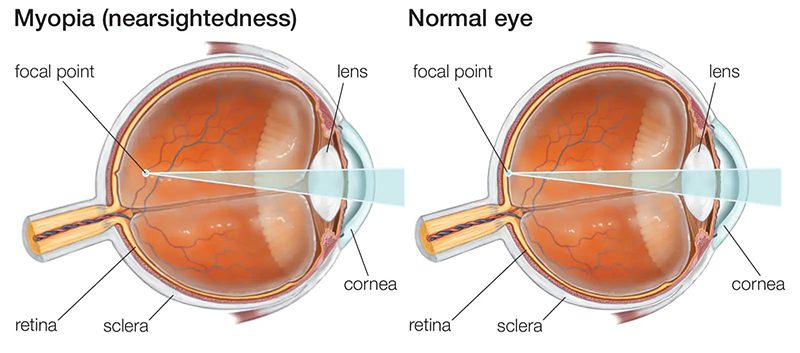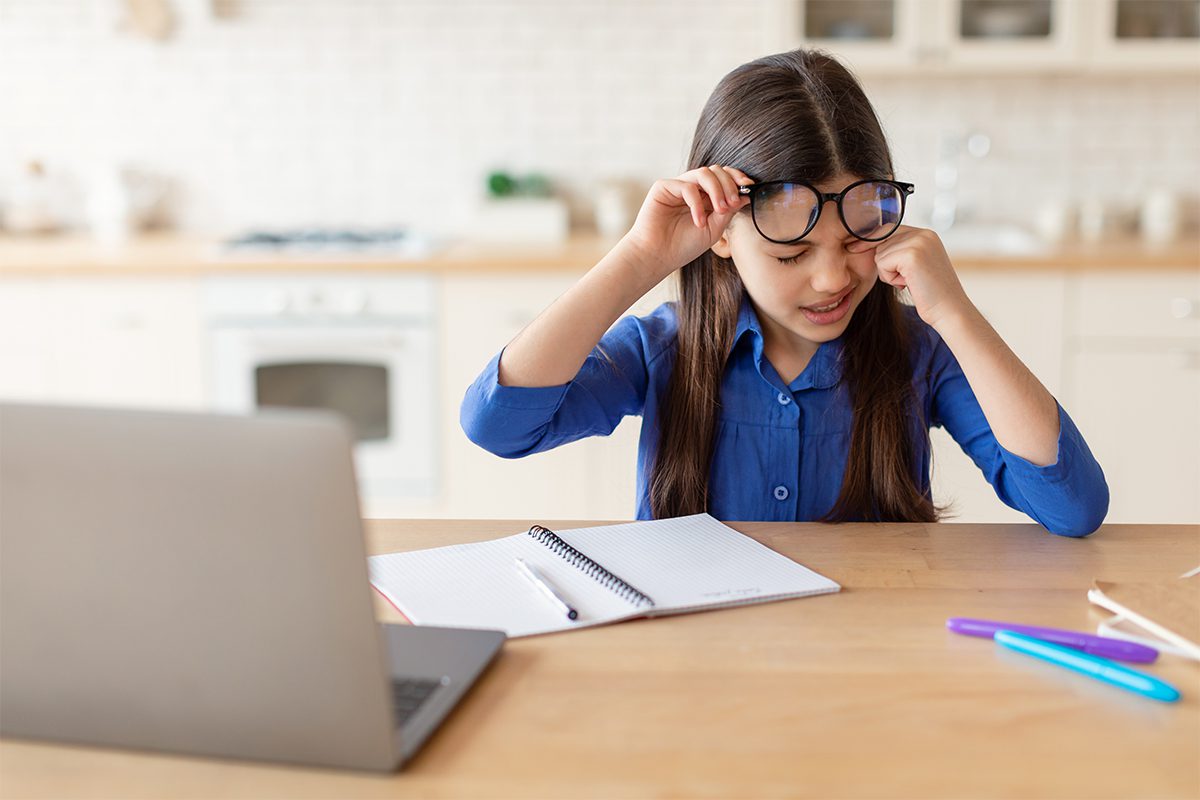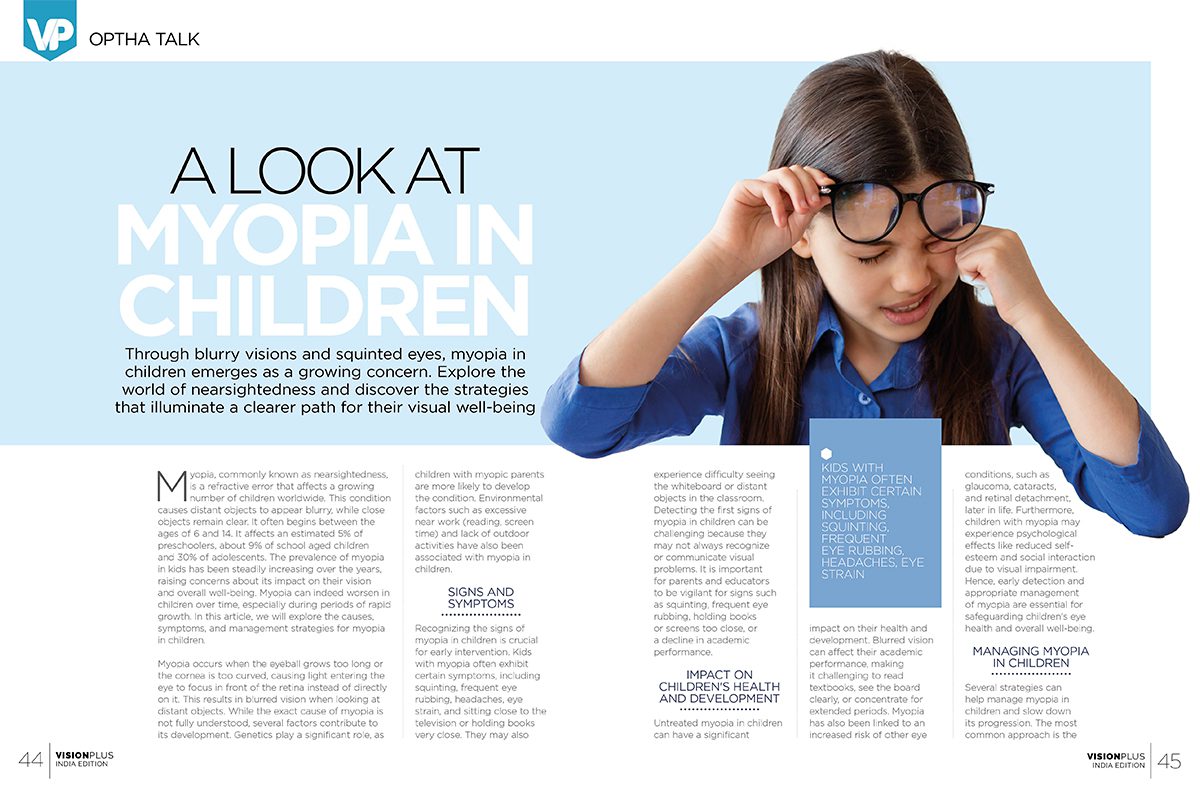
A Look At Myopia In Children
Through blurry visions and squinted eyes, myopia in children emerges as a growing concern. Explore the world of nearsightedness and discover the strategies that illuminate a clearer path for their visual well-being
Myopia, commonly known as nearsightedness, is a refractive error that affects a growing number of children worldwide. This condition causes distant objects to appear blurry, while close objects remain clear. It often begins between the ages of 6 and 14. It affects an estimated 5% of preschoolers, about 9% of school aged children and 30% of adolescents. The prevalence of myopia in kids has been steadily increasing over the years, raising concerns about its impact on their vision and overall well-being. Myopia can indeed worsen in children over time, especially during periods of rapid growth. In this article, we will explore the causes, symptoms, and management strategies for myopia in children.
Myopia occurs when the eyeball grows too long or the cornea is too curved, causing light entering the eye to focus in front of the retina instead of directly on it. This results in blurred vision when looking at distant objects. While the exact cause of myopia is not fully understood, several factors contribute to its development. Genetics play a significant role, as children with myopic parents are more likely to develop the condition. Environmental factors such as excessive near work (reading, screen time) and lack of outdoor activities have also been associated with myopia in children.
Signs and Symptoms
Recognizing the signs of myopia in children is crucial for early intervention. Kids with myopia often exhibit certain symptoms, including squinting, frequent eye rubbing, headaches, eye strain, and sitting close to the television or holding books very close. They may also experience difficulty seeing the whiteboard or distant objects in the classroom. Detecting the first signs of myopia in children can be challenging because they may not always recognize or communicate visual problems. It is important for parents and educators to be vigilant for signs such as squinting, frequent eye rubbing, holding books or screens too close, or a decline in academic performance.
Impact on Children's Health and Development
Untreated myopia in children can have a significant impact on their health and development. Blurred vision can affect their academic performance, making it challenging to read textbooks, see the board clearly, or concentrate for extended periods. Myopia has also been linked to an increased risk of other eye conditions, such as glaucoma, cataracts, and retinal detachment, later in life. Furthermore, children with myopia may experience psychological effects like reduced self-esteem and social interaction due to visual impairment. Hence, early detection and appropriate management of myopia are essential for safeguarding children's eye health and overall well-being.

Managing Myopia in Children
Several strategies can help manage myopia in children and slow down its progression. The most common approach is the use of corrective eyeglasses or contact lenses prescribed by an optometrist or ophthalmologist. These optical devices help children see clearly by correcting the refractive error. Another option is orthokeratology, where special rigid contact lenses are worn overnight to reshape the cornea temporarily. This method provides clear vision during the day without the need for glasses or contacts. A low dose of atropine eye drops are used to dilate the pupils during an eye exam may help slow down myopia in children between 5 and 18 years old.
Nutrients And Foods
Foods rich in vitamin A, omega-3 fatty acids, lutein, zeaxanthin, vitamin C, vitamin E, and zinc promote eye health by supporting retinal function, reducing inflammation, protecting against macular degeneration, and maintaining healthy blood vessels. Encouraging children to consume a variety of fruits, vegetables, whole grains, lean proteins, and healthy fats will provide them with a wide range of essential nutrients for overall eye health. It is important to note that while a nutritious diet supports eye health, it cannot reverse or prevent myopia on its own. Regular eye exams and following proper eye care practices are equally important for maintaining good vision in children with myopia.
Outdoor Activities
In addition to optical interventions, lifestyle modifications can be beneficial. Encouraging outdoor activities and reducing screen time are crucial steps in preventing myopia progression. Studies have shown that spending time outdoors, especially in natural light, can have a protective effect against myopia.
Between gaming, watching TV and movies, and doing school work, kids ages 8 to 18 spend more than seven hours a day looking at their laptops, phones and tablet.
While we can’t eliminate screen time entirely, we can encourage our children to spend more time outside.
Since myopia is primarily diagnosed in school-age children, exposure to the outdoor environment plays an important role in a child’s life with the potential to affect the progression of myopia. Increased time spent outdoors by children can slow myopia progression and may decrease the risk of new myopia onset by 50%.
Myopia in kids is a prevalent condition that can have a significant impact on children's vision, academic performance, and overall well-being. By understanding the causes, recognizing the symptoms, and implementing appropriate management strategies, parents, teachers, and healthcare professionals can help protect children's eye health.







